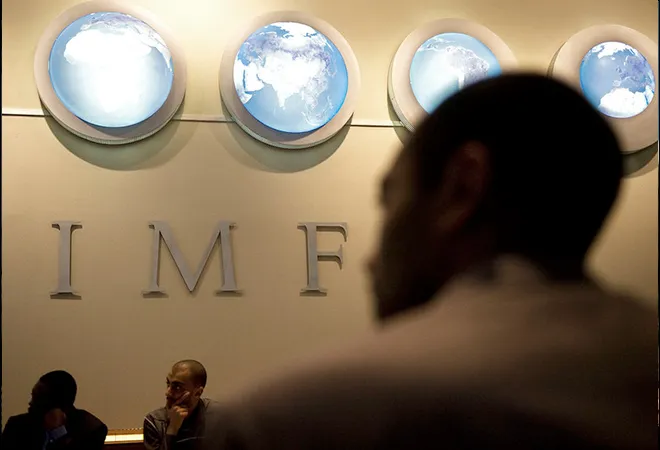-
CENTRES
Progammes & Centres
Location
Previous attempts at building alternate multilateral institutions like the New Development Bank and Asian Infrastructure Investment Bank have been hijacked by China.

A surprising bit of news, which got lost in the Covid news cycle of April, has come to light recently — India aligning with the US to oppose an expansion of International Monetary Fund (IMF) Special Drawing Rights (SDRs). SDRs are a form of international reserve currency, comprising of a mix of US Dollars, Euros, Sterling, Yen and Renminbi, issued by the IMF. Each country holds a quota of SDRs, which also determine its voting rights at the IMF board. Members can exchange their SDRs for a mix of these reserve currencies when required. An expansion of SDRs, therefore, means a larger resource base to draw on in times of crisis. This is generally considered a source of external stability and insurance against financial market volatility, reducing the need for amassing extensive foreign exchange reserves.
India has long pushed for an expansion of the IMF’s resources and reform of the quota system to fairly represent emerging markets. The last time this took place was in 2010, in response to the 2008 financial crisis, though it was implemented only in 2015 due to delayed ratification by the US Congress. The reforms led to some increase in India’s voting rights and removed the ability of the US and EU to unilaterally push through policy changes. The US, however, retains a veto over major decisions. India has demanded further quota reforms every year since 2016. FM Nirmala Sitharaman expressed her disappointment over the status quo as recently as October last year, stating that “this could seriously hamper the effectiveness of the IMF’s role in a crisis, as the only source which IMF could rely upon with certainty is its permanent resources, i.e. quotas.”
"India has long pushed for an expansion of the IMF’s resources and reform of the quota system to fairly represent emerging markets."
It is, therefore, difficult to understand why, in the throes of the biggest global crisis since the Great Depression, she decided to oppose the IMF’s proposal to issue new SDRs worth $500 billion. While the Finance Ministry press release following the IMF Committee meeting made no mention of this position, a report released in May stated that India did not support the issuance as “in the current context of illiquidity and flights to cash, the efficacy of an SDR allocation was not certain” and that national reserves should be the first line of defence.
On the face of it, this defies logic on multiples counts. First, Government of India (GoI) has been asking for a stronger global financial safety net ever since the Taper Tantrum of 2013, given heightened financial market volatility due to quantitative easing in the US and Europe. Failing to gain traction at the IMF, or swap lines with major central banks, they then set up the BRICS Contingency Reserve Arrangement (CRA). The liquidity unleashed by advanced economy central banks this time around dwarfs that of the 2008 financial crisis. Deteriorating relations with Beijing make drawing on the CRA unlikely. Strengthened insurance against financial market volatility should have been welcome.
"The liquidity unleashed by advanced economy central banks this time around dwarfs that of the 2008 financial crisis."
Even if the government considers domestic foreign exchange reserves adequate for managing financial markets, India’s fiscal position is stressed — just as in most emerging and developing economies. It’s worth remembering that when faced with a similar situation in Europe a few years ago, exceptional access to IMF resources was allowed for countries like Ireland, Portugal and Greece. Greece, in particular, had three IMF programmes, allowing it to borrow up to 3,200% of its quota, despite unsustainable debt levels. The exemption to debt sustainability rules which was created to allow this lending was removed one week before the quota reforms were ratified by the US Congress, ensuring that no other country in the world has such access.
As countries emerge from lockdown, citizens need both financial support and improved public health institutions, precisely when developing economies can least afford it. India is no different, fiscal spending from the government has been less than 2% of GDP despite the loss of 100 million jobs and the threat of millions becoming destitute. GoI could have demonstrated its leadership among developing countries by calling on the IMF to develop new instruments to support its members. There can be no better time to provide exceptional access to countries facing huge threats to lives and livelihoods. Instead, despite the magnitude of the crisis, about half of the IMF’s resources remain unused. This is not due to lack of demand, but the stringent qualification criteria and conditionality. The Short Term Liquidity Line (SLL), a quasi-swap line mediated by the IMF, was announced in April. Not one country has used it yet.
"Despite the magnitude of the crisis, about half of the IMF’s resources remain unused. This is not due to lack of demand, but the stringent qualification criteria and conditionality."
Finally, crises are an opportunity to accelerate reforms. An expansion in SDRs could have been combined with a reallocation of voting rights as in 2010, thereby increasing the voice of emerging markets in the governance of the IMF. It is obvious why the US, following its ‘America First’ policy would want to avoid this — particularly as it risks losing its veto. It’s less clear why India didn’t seize the moment. Previous attempts at building alternate multilateral institutions like the New Development Bank and Asian Infrastructure Investment Bank have been hijacked by China. This was a useful chance to strengthen the global governance system, and India’s influence in it.
This, however, provides a clue as to GoI’s reasoning. A quota review would certainly mean a large increase in voting rights for China, which is represented far below its economic weight, along with the US losing its veto power. The Chinese government’s track record of subverting international institutions, and the fact that only the US seems currently capable of standing against it, could have led to India making this choice. While the decision then appears reasonable, let’s not forget it comes with a cost. The Reserve Bank of India has around 18% of GDP locked up in forex reserves, a fraction of this would make a huge difference to the economy without putting fiscal stability at risk. Other countries need fiscal support even more than India does. Limiting China’s influence in global governance may be a worthy goal — can the Indian government find a better way to achieve it?
The views expressed above belong to the author(s). ORF research and analyses now available on Telegram! Click here to access our curated content — blogs, longforms and interviews.

Annapurna Mitra was Fellow at ORF. She led the Green Transitions Initiative at ORFs Centre for New Economic Diplomacy. ...
Read More +